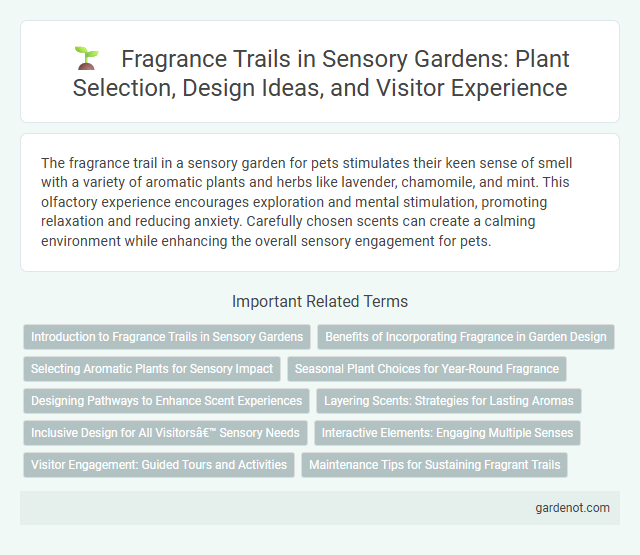The fragrance trail in a sensory garden for pets stimulates their keen sense of smell with a variety of aromatic plants and herbs like lavender, chamomile, and mint. This olfactory experience encourages exploration and mental stimulation, promoting relaxation and reducing anxiety. Carefully chosen scents can create a calming environment while enhancing the overall sensory engagement for pets.
Introduction to Fragrance Trails in Sensory Gardens
Fragrance trails in sensory gardens guide visitors through a carefully curated pathway of aromatic plants, enhancing sensory engagement and promoting relaxation. These trails feature diverse fragrant species such as lavender, rosemary, jasmine, and mint, chosen for their distinct scents and therapeutic properties. Designed to stimulate the olfactory senses, fragrance trails contribute to mental well-being and create immersive nature experiences for all ages.
Benefits of Incorporating Fragrance in Garden Design
Incorporating fragrance in a sensory garden enhances mental well-being by reducing stress and promoting relaxation through aromatherapy. Scented plants like lavender and rosemary stimulate memory and emotional connection, improving cognitive function. Fragrance trails also encourage exploration and engagement, increasing sensory stimulation and overall garden enjoyment.
Selecting Aromatic Plants for Sensory Impact
Selecting aromatic plants such as lavender, rosemary, and jasmine enhances the fragrance trail by providing strong, pleasing scents that engage visitors' olfactory senses. Incorporating a variety of plants with different blooming seasons ensures a continuous sensory impact throughout the year. Positioning herbs and flowers at accessible heights encourages interaction and maximizes the therapeutic benefits of the sensory garden.
Seasonal Plant Choices for Year-Round Fragrance
Seasonal plant choices in a fragrance trail enhance the sensory garden's appeal by ensuring a continuous release of captivating scents throughout the year. Incorporating spring blooms like lilacs and hyacinths transitions seamlessly into summer's fragrant jasmine and lavender, while autumn brings the warm aromas of chrysanthemums and cinnamon-scented plants. Winter interest is maintained with evergreens such as rosemary and pine, creating a dynamic olfactory experience that evolves with the seasons.
Designing Pathways to Enhance Scent Experiences
Designing pathways in a sensory garden's fragrance trail involves strategic placement of aromatic plants to maximize scent diffusion and visitor engagement. Curved and meandering paths encourage slower movement, allowing scents like lavender, rosemary, and jasmine to unfold gradually and create layered olfactory experiences. Incorporating tactile elements such as textured paving and sensory markers further enhances the immersive journey through diverse fragrance zones.
Layering Scents: Strategies for Lasting Aromas
Layering scents in a fragrance trail involves combining multiple aromatic plants to create a dynamic and evolving sensory experience. By selecting complementary fragrances with varying intensities and evaporation rates, such as lavender, rosemary, and gardenia, the trail maintains a lasting and memorable aroma throughout the garden. Strategic placement and seasonal rotation of these plants enhance scent longevity, engaging visitors continuously as they explore the sensory garden.
Inclusive Design for All Visitors’ Sensory Needs
A fragrance trail in a sensory garden incorporates diverse scents to engage visitors with varying sensory abilities, promoting inclusive design. Carefully selected aromatic plants and essential oils stimulate olfactory senses while accommodating sensitivities and allergies. This multisensory approach ensures accessibility and enjoyment for all visitors, including those with visual impairments or neurological differences.
Interactive Elements: Engaging Multiple Senses
Fragrance trails in sensory gardens feature interactive elements that stimulate multiple senses, including olfactory, tactile, and visual stimuli through aromatic plants, textured pathways, and colorful blooms. Visitors engage actively by touching leaves, smelling herbs, and following scented routes, enhancing sensory integration and cognitive connection. These multisensory interactions foster relaxation, memory recall, and heightened sensory awareness.
Visitor Engagement: Guided Tours and Activities
The fragrance trail in a sensory garden enhances visitor engagement by offering guided tours that educate participants about aromatic plants and their sensory benefits. Interactive activities like scent identification and herb harvesting allow visitors to actively explore and connect with the diverse fragrances. These immersive experiences promote sensory awareness and create lasting memories linked to natural aromas.
Maintenance Tips for Sustaining Fragrant Trails
Regular pruning of aromatic plants like lavender and rosemary ensures robust growth and consistent scent release along fragrance trails. Applying organic mulch helps retain soil moisture and suppresses weeds, enhancing plant health and fragrance intensity. Periodic soil testing and balanced fertilization support optimal nutrient levels, sustaining vibrant and long-lasting fragrant pathways.
Fragrance trail Infographic

 gardenot.com
gardenot.com